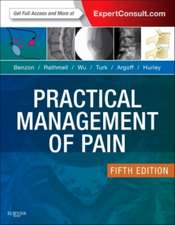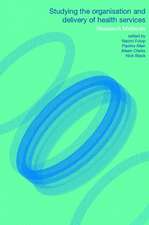Look At It This Way
en Limba Engleză Paperback – 19 feb 1998
The books will be invaluable to everyone working with children with special needs - parents, therapists, toy librarians, teachers, health visitors, playgroup leaders, child minders and all who play with children in hospitals, hostels or at home.
Preț: 126.27 lei
Preț vechi: 132.92 lei
-5% Nou
Puncte Express: 189
Preț estimativ în valută:
24.16€ • 25.07$ • 20.20£
24.16€ • 25.07$ • 20.20£
Carte tipărită la comandă
Livrare economică 18 martie-01 aprilie
Preluare comenzi: 021 569.72.76
Specificații
ISBN-13: 9780750638951
ISBN-10: 0750638958
Pagini: 160
Ilustrații: 61 ills.
Dimensiuni: 189 x 246 x 8 mm
Greutate: 0.27 kg
Editura: Elsevier
Locul publicării:United Kingdom
ISBN-10: 0750638958
Pagini: 160
Ilustrații: 61 ills.
Dimensiuni: 189 x 246 x 8 mm
Greutate: 0.27 kg
Editura: Elsevier
Locul publicării:United Kingdom
Public țintă
Primary: Occupational therapists, physiotherapists, nurses, involved with these children.Secondary: Parents, teachers, carers.
Cuprins
Contents; Introduction; Before you begin; Materials used; Mail order firms; Play for a child with a visual impairment; Keeping toys within reach; For children playing on the floor; For children playing at a table; For children who tend to scatter their toys; Toys and play for children who are lying down; Learning to focus on a fixed object; Toys to encourage looking at a fixed object; Learning to track; Learning to scan; Looking around; Games for older children; Learning to identify colours; Learning to listen; Making opportunities for attentive listening; Homemade noisemakers; Toys with an inbuilt noise; Touch; Exploring textures; Texture matching; Some toys and activities to encourage the use of hands; Dressing skills - zips, buttons and poppers; Tactile games; Smell.
Recenzii
From previous editions of 'Play Helps':
The book is well written and set out in an accessible way that allows you to dip into it for ideas. I would recommend it to all parents and professionals in the educational field - it provides useful concepts to stimulate youngsters with specific handicaps and learning difficulties and also provides good ideas for the busy parent to use in different situations. New Generation.
Here is a most imaginative and stimulating volume which ... is packed to over-flowing with delightful play ideas ... Primarily for parents and those working with handicapped children, it would prove valuable for anyone with an interest in helping children to enjoy learning through play. Physiotherapy.
Mrs Lear approaches every child, however handicapped, as a unique individual with special needs, likes and dislikes. Her refreshing simplicity permeates the book which is brimming with humour and practical advice. Mother.
Review of this new edition:
"For those therapists, carers and others who work with children with special needs, Roma Lear's 'Play Helps' series will be a familiar sight on the bookshelf. This volume deals specifically with aspects of play for children who have varying degrees of visual impairment. It is likely to be used as a resource to dip into for ideas on toys to make and activities and games to play with the finished items.
However, the book takes you from the first chapter which sets out the preparatory materials of paper, thread, tapes and so on, and gives useful contact addresses for craft and educational toy supplies. It then proceeds through the senses of hearing, touch, small and vision and expands on each of these with relevant suggestions for toys and games to develop the children's sensory awareness in line with their visual abilities.
Each chapter is well written in easy-to-understand language - no medical or technical jargon anywhere. There are lots of delightful sketches to accompany the step-by-step instructions, which also tell you whether the toy is quick to make, long lasting, etc, and in which situations it is useful. All of the games and toys are said to be in the low technology bracket - easy to make and using materials available through everyday recycling, eg cardboard tubes and boxes or from High Street stores or mail order.
The author uses a story tale to illustrate how some of the toys have been created and subsequently enjoyed - thus making each chapter an adventure in itself.
References are made to children and their carers but as the author quotes in the introduction: 'The process of play is far more important than the toys.' This book is about having fun with only a whiff of therapy.
It is published in paperback with a bright colourful cover...
This book would be a useful reference for paediatric therapists (physiotherapy and occupational therapy), teachers, nursery nurses and families and carers of young children with visual impairment."
Susan K Walmsley MCSP, Physiotherapy Frontline, Feb 1999
The book is well written and set out in an accessible way that allows you to dip into it for ideas. I would recommend it to all parents and professionals in the educational field - it provides useful concepts to stimulate youngsters with specific handicaps and learning difficulties and also provides good ideas for the busy parent to use in different situations. New Generation.
Here is a most imaginative and stimulating volume which ... is packed to over-flowing with delightful play ideas ... Primarily for parents and those working with handicapped children, it would prove valuable for anyone with an interest in helping children to enjoy learning through play. Physiotherapy.
Mrs Lear approaches every child, however handicapped, as a unique individual with special needs, likes and dislikes. Her refreshing simplicity permeates the book which is brimming with humour and practical advice. Mother.
Review of this new edition:
"For those therapists, carers and others who work with children with special needs, Roma Lear's 'Play Helps' series will be a familiar sight on the bookshelf. This volume deals specifically with aspects of play for children who have varying degrees of visual impairment. It is likely to be used as a resource to dip into for ideas on toys to make and activities and games to play with the finished items.
However, the book takes you from the first chapter which sets out the preparatory materials of paper, thread, tapes and so on, and gives useful contact addresses for craft and educational toy supplies. It then proceeds through the senses of hearing, touch, small and vision and expands on each of these with relevant suggestions for toys and games to develop the children's sensory awareness in line with their visual abilities.
Each chapter is well written in easy-to-understand language - no medical or technical jargon anywhere. There are lots of delightful sketches to accompany the step-by-step instructions, which also tell you whether the toy is quick to make, long lasting, etc, and in which situations it is useful. All of the games and toys are said to be in the low technology bracket - easy to make and using materials available through everyday recycling, eg cardboard tubes and boxes or from High Street stores or mail order.
The author uses a story tale to illustrate how some of the toys have been created and subsequently enjoyed - thus making each chapter an adventure in itself.
References are made to children and their carers but as the author quotes in the introduction: 'The process of play is far more important than the toys.' This book is about having fun with only a whiff of therapy.
It is published in paperback with a bright colourful cover...
This book would be a useful reference for paediatric therapists (physiotherapy and occupational therapy), teachers, nursery nurses and families and carers of young children with visual impairment."
Susan K Walmsley MCSP, Physiotherapy Frontline, Feb 1999








